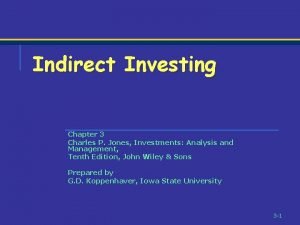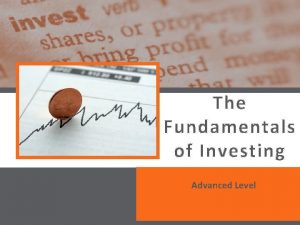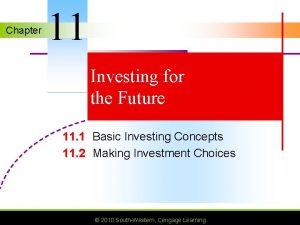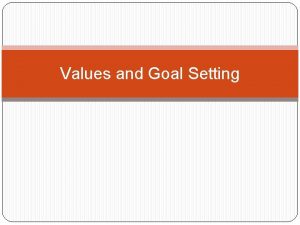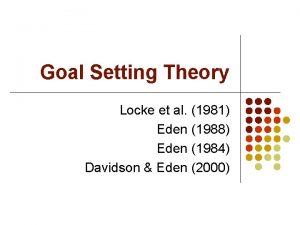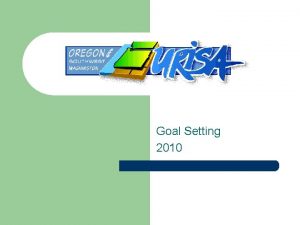Investing Fundamentals Investing for the Future Goal Setting




















- Slides: 20

Investing Fundamentals

Investing for the Future: Goal Setting • Investment goals should be specific and measurable. Develop your goals by asking questions: • • What will I use the money for? How much will I need? How will I get the money I need? How long will it take me to get the money I need? • How much risk am I willing to take on? 13 -2

Goal Setting (continued) • What could make me change my goals? • Given my economic circumstances, are my investment goals reasonable? • Am I willing to make the sacrifices necessary, to meet my goals? • What will the consequences be if I don’t reach my investment goals? 13 -3

First Steps • Get a good education and good training to win the means to finance your future. • Establish a budget and stick to it. • Establish a savings account. • Save for emergencies (3 – 9 months of living expenses). • Save for your education. • Save to invest. • Avoid debt. • Make sure you are insured. 13 -4

Second Steps • Start or have someone start for you a Roth IRA • Choose a reputable no-load mutual fund or Exchange-traded fund. Plow into your future as much as you can of gifts, inheritances, and windfalls. 13 -5

Third Steps • Participate in any 401(k) or other savings / investing plan your employer may offer. • Add to your portfolio of mutual funds and exchange-traded funds. • Educate yourself about other possibilities, such as investing directly in the stock market.

The Value of Investing into and for the Future • Many people don’t start investing because they only have a small amount to invest, but. . • Even small amounts invested regularly grow over a long period of time. • If you save $2, 000 each year at 5%, you would have $241, 600 at the end of 40 years. The higher the rate of return the greater the risk. 13 -6

Factors Affecting the Choice of Investments • Safety and risk. • Safety means a lessening of the possibility of losing your money. • Risk means hat there’s a chance you WILL lose your money. • Investments range from very safe to very risky. • The greater the risk, the greater the potential return: risk is best borne by the young. 13 -7

Five Components of Risk • Inflation risk - during periods of high inflation your investment return may not keep pace with the inflation rate. • Interest rate risk - you may invest in a bond at a 6%, rates later go up to 8%; your bond price falls. • Business failure risk - bad management or products affect stocks and corporate bonds. • Market risk - prices fluctuate because of behaviors of investors. • Global investment risk - changes in currency affect the return on your investment. 13 -8

Investment Risk: the Lows and Highs • Safe investments = predictable and low income. • Savings accounts and certificates of deposit. • U. S. savings bonds. • United States treasury bills. • Riskier investments = higher potential income. • • • Municipal bonds. Corporate bonds. Preferred stocks and income common stocks. Income mutual funds. Real estate rental property. 13 -9

Investment Growth and Liquidity • Growth: investment will increase in value over time. • Liquidity. • The ability to buy or sell an investment quickly without substantially affecting the investment’s value. • Cash is immediately liquid. • Savings is very liquid. • Precious metals are not very liquid. • Real estate is not very liquid. 13 -10

Asset Allocation and Diversification • Asset allocation is the process of spreading your assets among several different types of investments, usually by percentage, to lessen risk. • Determine what percent you want in stock, bonds, CDs, and mutual funds based on your time frame, age, and tolerance for risk. • Investing in different asset classes provides diversification. • Younger investors generally should put a larger percentage in growth-oriented investments. 13 -11

Investment Alternatives - Stock • Stock or equity financing. • Equity capital is provided by stockholders, who buy shares of a company’s stock. • Stockholders are owners and share in the success of the company. • A corporation is not required to repay the money obtained from the sale of stock. • They are under no legal obligation to pay dividends to stockholders. They may instead retain all or part of earnings. 13 -12

Investment Alternatives - Bonds • Corporate and government bonds. • A bond is a loan to a corporation, the federal government, or a municipality. • Bondholders receive periodic interest payments, and the principal is repaid at maturity (1 -30 years). • Bondholders can keep the bond until maturity or sell it to another investor before maturity. 13 -13

Investment Alternatives – Mutual Funds • Mutual funds. • Investors’ money is pooled and invested by a professional fund manager. • You buy shares in the fund. • Provides diversification to reduce risk. • Funds range from conservative to extremely speculative. • Match your needs with a fund’s objective. 13 -14

Investment Alternatives - Real Estate • The goal of a real estate investment is to buy a property and sell it at a profit. Nationally, 3% appreciation in price a year is average. • Location, location is important. 13 -15

Speculation – Don’t Be Stupid! • Speculative investments. • A speculative investment is a high-risk investment made in the hope of earning a relatively large profit in a short time. Typical speculative investments include: • • • Antiques and collectibles. Options. Commodities. Coins and stamps. Precious metals and gemstones. 13 -17

A Personal Investment Plan • Establish realistic goals. • Determine the amount of money needed to meet your goals. • Specify the amount of money available to fund your investments. • List different investments you want to evaluate. • Evaluate risk and potential return for each. • Reduce possible investments to a reasonable number. • Choose at least two different investments. • Continue to evaluate your investment program. 13 -18

Your Role in the Investment Process • Evaluate potential investments. • Seek the assistance of a financial planner (see Appendix at the back of the text). • Monitor the value of your investments. • Keep accurate and current records. • Consider the tax consequences of selling your investments. 13 -19

Sources of Investment Information • The internet. • A wealth of investment information is available. • View sites such as www. fool. com, www. cnn. com , and www. money. com • Newspapers and news programs. • Business periodicals such as Smart Money and government publications. • Corporate Reports. • Investor services and newsletters, such as Value. Line or Morningstar. 13 -20
 Indirect investing
Indirect investing Future perfect e future continuous
Future perfect e future continuous Future continuous tense rules
Future continuous tense rules Take charge today the fundamentals of investing
Take charge today the fundamentals of investing Everfi future smart investing in you answers
Everfi future smart investing in you answers The spreading of risk among many types of investments
The spreading of risk among many types of investments Backwards goal setting
Backwards goal setting Importance of goal setting for athletes
Importance of goal setting for athletes Gcse pe goal setting
Gcse pe goal setting Short term goals for teenager
Short term goals for teenager What is goal setting
What is goal setting Dapps goals examples
Dapps goals examples T tess smart goal examples
T tess smart goal examples Goal setting slides
Goal setting slides Goal setting ladder
Goal setting ladder Objectives of goal setting
Objectives of goal setting Goal acceptance
Goal acceptance Biblical goal setting worksheet
Biblical goal setting worksheet Locke et al 1981
Locke et al 1981 Decision making goal setting
Decision making goal setting Managerial planning and goal setting
Managerial planning and goal setting
